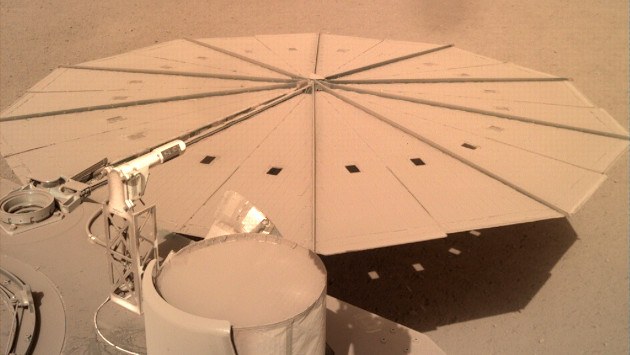Martian dust reduces power for InSight – but measurements are ongoing

NASA's InSight lander has been operating on Mars for a good year and a half during its extended mission. However, the lander has been struggling for a considerable time with a reduction in available power, which is due to the increasing quantities of Martian dust covering its solar panels. This dust can only be removed by sufficiently strong Martian winds. However, despite detecting many passing whirlwinds, none have cleaned off the solar panels.
The available energy has had to be planned for and used very carefully during recent months. The overall focus has been particularly on the scientific measurements of the mission. The teams involved, led by NASA's Jet Propulsion Laboratory (JPL) and Lockheed Martin, which operates the lander, have managed to keep this unique mission in operation until now. When InSight landed, its solar panels were producing approximately 5000 watt-hours per Martian day, or sol. Now, at 500 watt-hours per sol, they produce only about a tenth of this. And the Martian dust on the panels continues to increase while the Sun's elevation at the landing site decreases as winter sets in.

DLR's Mars 'Mole' ceased its hammering activities in January 2021. Before that, it provided us with important insights into the properties of the Martian soil. The Mole itself and the temperature sensors on the measurement cable, together with the still fully functional radiometer of the Heat Flow and Physical Properties Package (HP³) experiment package, continue to be of great use to us as a thermal probe. The HP³ and InSight teams have managed to take many energy-intensive measurements over the past few months, despite the energy shortage. They have been able to measure how deep the daily temperature wave penetrates below the surface and the heaters in the Mole have been used to measure the thermal conductivity of the soil. In addition, all-day measurements of the surface temperature have been conducted with the radiometer. Also, a partial solar eclipse by the Martian moon Phobos could be observed at the landing site in March this year. Since solar radiation is currently decreasing at the landing site with the onset of winter, the midday temperatures at the surface have dropped by five degrees Celsius or more in recent weeks. Currently, the maximum temperature at midday is around 14 degrees Celsius.
In the coming mission phase, fewer and fewer measurements will be possible as the energy supply decreases. By the end of May, all InSight instruments except the seismometer will gradually be switched on less frequently. The HP³ team will now fully concentrate on radiometer measurements. The command sequences are currently being adapted to cope with the challenges ahead.

In consultation with the mission's science and operations teams, attempts are being made to perform scientific measurements on Mars for as long as possible. The seismometer is operated primarily at certain times of the day, for example at night, when the winds are weak, and the seismometer can detect Mars quakes more easily. For example, just a few days ago on 4 May 2022, it succeeded in detecting the strongest Mars quake ever measured. Seismometer measurements are expected until the end of the summer. At that time the seismometer will be off, though the lander will still have enough power to take occasional pictures and communicate with Earth. By December, however, the energy supply is expected to be so low that the InSight team anticipates that one day InSight will simply stop responding. What remains is hope for wind to remove some of the dust. If only 25 percent of InSight's panels were cleared of wind, the lander would have approximately 1000 more watt-hours available per sol – enough to continue collecting scientific data.

You can find more images of the InSight mission on the NASA website.
Tags:
